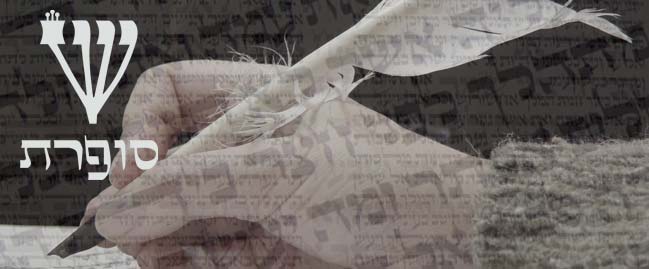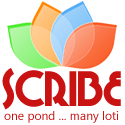תמחה את זכר עמלק
בס"ד
21 Iyyar
Tim'cheh et zeykher Amaleyq
"Blot out the remembrance of Amalek..." - Devarim/Deuteronomy 25:19, parshat Ki Tetze
This is said by a congregation, together with the sofer, at the Siyum Ha-Torah held to dedicate a new Torah scroll (sometimes to re-dedicate a repaired scroll, too!).
This is also what a scribe must say each morning as he (or I) begin/s work. As the kulmus, quill or reed, must be tested & sometimes re-shaped each morning. This test must also be performed each time the kulmus is cut or sharpened, as no writing of any STaM (Sifrei Torah, Tefilin & Mezuzot) may be commenced until the writing implement has passed this check. So what is the test?
Dip your nib into your bet d'yo (inkwell), & write the name Amaleyq. As you speak the words "Tim'cheh et zeykher Amaleyq", cross it out.
This is one of those "invisible things" I've referred to that sof'rim do in our work that are required for us to perform according to Jewish Law. Things that nobody can tell by looking at a scroll whether they have been correctly performed. This is why you need to have complete trust in your sofer. No different than your lawyer, your doctor, or your jeweller...
What's more, if this ritual is not performed before any writing or repairing of letters, then all of the work you do is pasul. Not kosher. Bury it.
Torah-scribes may not write any part of a Torah-scroll, nor repair any of its letters, until the name of Amalek is written and completely blacked-out in fulfillment of the command in Deuteronmy 25:17. (ie. to blot-out the name of Amalek"...)
-- Rabbi Dr Eric Ray, z"l, Sofer STaM
Does this seem harsh? Perhaps. People I've met in my travels who have tried their hand at writing or correcting sofrut without being fully trained thought so. Maybe because the first they had heard of this was from me & it has severe implications for their product. But instead of brushing this requirement aside, let's unpack this both practical & vital practice...
Who was Amaleyq?
Jewish Encyclopedia.com gives a biblical-historical overview, while Wikipedia gives their own interesting version followed by religious, historical & philosphical links. Highly recommened before you read on :)
The name "Amaleyq", when you divide it up into two words, reads "עמ לק", am laq, a greedy people, a nation of takers. Am means nation or people, where laq indicates lapping something up greedily. We can extrappolate further by noticing that the Hebrew word amal means trouble, misery, evil; the word laqah means stricken, defective, blemished, flawed, spoiled.
These people, who preyed upon the fledgling Jewish nation as we crossed the Sinai, did so by picking off those who were bringing up the rear. The elderly, the children, the ill. They took advantage of other human beings who were weaker than they. A cowardly act, to attack the defenseless. G@d hates that.
So does this mean that Jewish scribes are responsible for committing a conscious ritual act of genocide with each test of the pen? That a xenophobic grudge is expressed in one of our most sacred practices? No.
There are three mitzvot connected to Amaleyq, all from mitzvah-book 14, the Book of Judges:
#598 - Blot out Amaleyq (Devarim/Deuteronomy 25:19)
#599 - Remember what the Amaleyqites did to the Jewish People (Devarim/Deuteronomy 25:17)
#600 - Don't forget Amaleyq's atrocities & ambush on our journey from Egypt in the desert (Devarim/Deuteronomy 25:19)
#599 & #600 are applicable at all times, anywhere in the world to all Jewish men & women above the ages of 13 & 12, respectively. #598 is equally applicable in all places at all times, but only adult Jewish men are obligated in this mitzvah. Adult Jewish women are free to choose to take this commandment on, if we wish.
How do we observe these mitzvot?
Rashi explains #600:
"From man unto woman, from infant unto suckling, from ox unto sheep, so that the name of Amalek not be mentioned even with reference to an animal by saying "This animal belonged to Amalek".
#599 is fulfilled by Shabat Zakhor, which I already wrote about here & here, the Shabbes before Purim when we chant passages relating to Amaleyq & his descendant Haman, who is the villain in the Purim story.
That leaves #598. The way we fulfill this mitzvah today is precisely what I described above: writing out his name to check your nib & crossing it out, making the verbal declaration, with three diagonal strokes.
So, nu? Why the big production?
On the one hand, this test provides a very practical, mechanical step to writing. All professional calligraphers, regardless of origin, test their nibs in between dipping & writing. It's the only way to make certain your fine strokes will be fine, your wide strokes wide, & that there will be just the right amount of ink (no blobs or streaks). So of course writing a Sefer Torah, Mezuzah, or Tefilin (& Megillot, for that matter), deserves this conscious process, out of respect & because of it's content.
On the other hand, this is in fact a mitzvah connected to a very high, spiritual exercise, calling us to change ourselves from within. Ourselves???
What or who is Amaleyq today?
You are. I am.
Amaleyq is the temptation to take advantage of others, to see only with your own eyes, to feed our appetites off the disempowered.
So with each test of the pen, a sofer is called to remember that very unfortunate human tendency, that it lies dormant within, & that it is his responsibility to keep it in check, if not destroy it.
To kill the predator inside.
Now, back to the party...
The completion of this ritual occurs each year on Erev/the day before Tish'a b'Av, which occurs on August 3rd this year. On that day, I take all the accumulated scraps of kosher parchment on which I wrote & crossed out literally thousands of Amaleyim, & burn them. The sofer holds a public outdoor service for the incineration, which includes prayer, recitations from the Books of Nachum, Yishaiyahu (Isaiah), Tehilim (Psalms) & Ovadiyah (Obadaiah), then concludes with blessings specific to this mitzvah. At the end, everyone present says "ameyn!".
Then we eat :D
So as you can see, this requirement isn't harsh at all. This is a beautiful, consciousness-raising exercise that, when practiced regularly, aids the sofer to imbue his work with appropriate intention & awareness. The work becomes Work. It allows us to gradually & gently correct one of our most negative tendencies, thus bringing our best Selves to the holy service of writing.
Technorati tags: religion, religion and philosophy, Judaism, Torah, Canada, journal, weblog, blog, diary, soferet, sofrut, scribe, art, thoughts, stam, feminism, safrut, women, ritual, prayer, service, writing, genocide, Egypt, Technorati.














0 Comments:
Post a Comment
<< Home